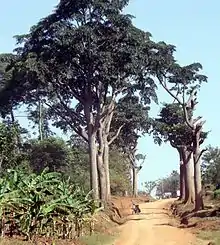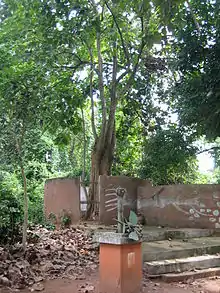Iroko
Iroko (also known as ọ́jị̀ in Igbo language, 'uloho' in the Urhobo language of Southern Nigeria, and as odum in the Kwa languages of Ghana[1]) is a large hardwood tree from the west coast of tropical Africa that can live up to 500 years.[2] This is the common name for the genus Milicia, in which there are two recognized species, which are closely related: Milicia excelsa and Milicia regia.[3]
| Iroko | |
|---|---|
 | |
| Milicia excelsa, Uganda | |
| Scientific classification | |
| Kingdom: | Plantae |
| Clade: | Tracheophytes |
| Clade: | Angiosperms |
| Clade: | Eudicots |
| Clade: | Rosids |
| Order: | Rosales |
| Family: | Moraceae |
| Tribe: | Moreae |
| Genus: | Milicia Sim |
| Species | |

The tree is known to the Yoruba as ìrókò, logo or loko and is believed to have supernatural properties.[4] Iroko is known to the Igbo people as ọjị wood.[5] It is one of the woods sometimes referred to as African teak, although it is unrelated to the teak family. The wood colour is initially yellow but darkens to a richer copper brown over time.
Species
Iroko is yielded mostly (probably) by Milicia excelsa. In much of the literature on this timber the names of the trees that yields it are given as Chlorophora excelsa (syn. Milicia excelsa) and Chlorophora regia (syn. Milicia regia).[6][7]
Milicia excelsa is currently listed as 'lower risk/near threatened' on the IUCN Red List.[8]
Uses

The wood is used for a variety of purposes including boat-building, domestic flooring, furniture and outdoor gates. From the late 1990s, it was used as part of the txalaparta, a Basque musical instrument constructed of wooden boards, due to its lively sound.[9] Iroko is one of the traditional djembe woods. Iroko wood was the wood chosen for the pews in the Our Lady of Peace Basilica.[10]
It is a very durable wood;[11] iroko does not require regular treatment with oil or varnish when used outdoors, although it is very difficult to work with tools as it tends to splinter easily, and blunts tools very quickly.[12]
In the UK there are no trade restrictions on the machining of this timber. The only reported adverse effects known to be caused by the dust from iroko are asthma, dermatitis and nettle rash.[13]
Cultural beliefs
The tree is feared in some cultures where it originates and hence is shunned or revered with offerings.[14] Yoruba people believe that the tree is inhabited by a spirit, and anybody who sees the Iroko-man face to face becomes insane and speedily dies.[15] According to the Yoruba, any man who cuts down any iroko tree causes devastating misfortune on himself and all of his family,[15] although if they need to cut down the tree they can make a prayer afterwards to protect themselves.[16]
They also claim that the spirit of the Iroko can be heard in houses which use iroko wood, as the spirit of the Iroko is trapped in the wood.[15] In Nigeria the iroko wood is of much lower quality due to soil conditions as well as root-rot.[17][18][19] Some Westerners refer to the wood as "poor man's teak".[20]
References
| Wikispecies has information related to Milicia. |
- Blench, Roger (2006). Archaeology, language, and the African past. Altamira Press. ISBN 9780759104655.
- Amadi, Pete (1 September 2013). Conflicted Destiny: Chronicle of a Natural Born Warrior. FriesenPress. ISBN 9781460224274.
- D.A. Ofori; M.D. Swaine; C. Leifert; J.R. Cobbinah; A.H. Price (December 2001), "Population genetic structure of Milicia species characterised by using RAPD and nucleotide sequencing L.", Genetic Resources and Crop Evolution, 48 (6): 637–647, doi:10.1023/A:1013805807957, S2CID 43985297
- Oduyoye, Modupe (29 September 2015). The Sons of the Gods and the Daughters of Men: An Afro-Asiatic Interpretation of Genesis 1-11. Wipf and Stock Publishers. ISBN 9781498235822.
- Onunwa, Udobata R. (27 June 2010). A Handbook of African Religion and Culture. Dorrance Publishing. ISBN 9781434953964.
- iroko wood, Encyclopædia Britannica on-line
- Chlorophora excelsa (Welw.) Benth., Taxonomic Serial No.: 506548, Integrated Taxonomic Information System
- "The IUCN Red List of Endangered Species: Milicia excelsa", The IUCN Red List of Endangered Species
- "La txalaparta, el sonido ancestral de Euskadi por Pol Ducable Rogés". CANCIONEROS.COM. Retrieved 4 March 2016.
- Elleh, Nnamdi (1 January 2002). Architecture and Power in Africa. Greenwood Publishing Group. ISBN 9780275976798.
- Kurjatko, Stanislav; Kúdela, Jozef; Lagaňa, Rastislav (1 January 2006). Wood Structure and Properties '06. Arbora Publishers. ISBN 9788096886845.
- Westin, Mike (12 April 2013). Upgrading Your Boat's Interior. A&C Black. ISBN 9781408159095.
- "HSE Toxic Woods Information Sheet" (PDF). Health and Safety Executive.
- Twilight Tales3. CUP Archive. 1953. p. 26. Retrieved 2 April 2011.
- Ogumefu, M. I. (1929). Yoruba legends. Forgotten Books. p. 10. ISBN 978-1-60506-017-0.
- The Church Missionary Juvenile Instructor. Seeley, Jackson, & Halliday. 1 January 1880.
- Bulletin of the Imperial Institute. The Institute. 1 January 1914. p. 366.
- Commons, Great Britain Parliament House of (1 January 1914). House of Commons Papers. H.M. Stationery Office.
- Documentation and Information: Ecology : Catalogue of Documents and Publications on MAB in Africa. UNESCO's Regional Office. 1 January 1990.
- Hamon, Lindsay (7 November 2012). When God Takes Over: Stories of hope on the streets. AuthorHouse. ISBN 9781477238844.
External links
- Toxic woods (HSE)